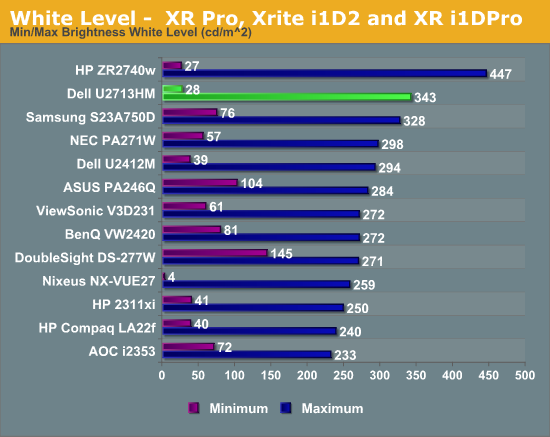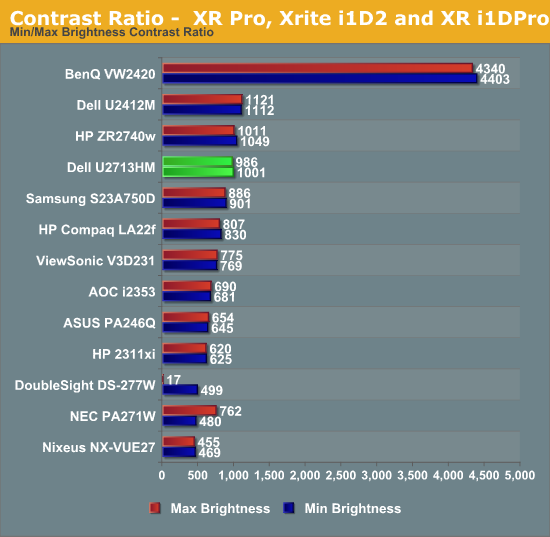Dell U2713HM - Unbeatable performance out of the box
by Chris Heinonen on October 4, 2012 12:00 AM ESTDell U2713HM Brightness and Contrast
Last review I changed how I measured brightness and contrast to use a 5x5 ANSI grid instead of solid black and white screens in order to provide more accurate data. I wasn’t sure how this would impact screens, making comparisons between models harder. Measuring the center square of the 5x5 ANSI grid, the maximum brightness I could obtain from the U2713HM is 343 nits, which is very close to the 350 nits listed in the specs. With the backlight set to minimum that drops down to 28 nits, giving you a wide range of brightness levels to choose from.

Black levels are where I expected the most impact with the new testing, since an ANSI grid prevents LED systems from going to full black. Preventing these systems from kicking in gives a much better real-world idea of the contrast ratio for a monitor. The U2713HM does a good job with the new measurements, as seen in the chart below.

Figuring out the contrast ratio from the avove data is simple. There’s some slight rounding, but otherwise we see contrast ratios very close to 1000:1 for the display at both maximum and minimum brightness. This stacks up very well compared to all the other 27” displays that have been tested, and using a more stringent standard. The contrast numbers from the Dell are very good overall,

With a good foundation of brightness and contrast levels, it’s time to see how the Dell performs with color.










101 Comments
View All Comments
Gothmoth - Thursday, October 4, 2012 - link
yeah that´s bad.. i currentyl have 3 samsung 24 inch displays.during the three year warranty i send one of them in 3 times the other 2 times for repair.
defective powerboard each time. if they die again im out of luck.
that´s why i am frightened to buy expensive gear.
it will only last for the warranty period.... :(
peterfares - Thursday, October 4, 2012 - link
Did you fix it according to the directions on that site? Seems like an easy fix, just need to change out one large through-hole component.layte - Friday, October 5, 2012 - link
I have the parts arriving shortly. Looks like getting into it will be just as difficult as the soldering job.seapeople - Monday, October 8, 2012 - link
Dell's customer service is great considering you have reasonable expectations.Did your Dell equipment break while in warranty? If so, then call Dell, *boom* they give you a new one, and if they don't have that model, they give you the newer version of that model.
Did your Dell equipment break while not in warranty? If so, then you're on your own. If that bothers you, then buy the extended warranty, or otherwise buy something you can afford to replace on the chance it breaks out of warranty.
ajp_anton - Thursday, October 4, 2012 - link
The reviewed monitor is gone in the processing lag chart, unless it's name was changed to the U2412 which has the correct value from the chart above.For power usage, "Even with the backlight at maximum and the screen pure white".
Normally in TN panels a black pixel uses slightly more power than a white one (how negligible is this btw?). Is it different for IPS, or have they changed it?
mczak - Thursday, October 4, 2012 - link
Yeah this is indeed reversed for both VA and IPS in theory (TN needs active transistor to block light, VA and IPS need active transistor to let light through - this is also the reason dead pixels are more likely to be always lit with TN but always black with IPS/VA).That said though the difference should be pretty minimal - if you'd have a dynamic backlight that would far outweigh such effects.
TheManWithThePlan - Thursday, October 4, 2012 - link
This monitor seems to have worse calibration out of the box. The U2711 review had an uncalibrated 2.24 DeltaE.http://www.anandtech.com/show/2922/3
Have the testing methodologies changed or are the monitors objectively worse measuring?
cheinonen - Thursday, October 4, 2012 - link
Almost all previous models were measured using a XR Pro or an i1Display2, which are colorimeters that are subject to drift over time, and inherently not as accurate as a spectrometer. They also have issues with non-traditional CCFL lighting, which can include wide gamut CCFL, LED, and OLED. Last year I moved all display reviews to use an i1Pro spectrometer, which does not have these issues at all and is NIST certified to have a maximum error of 1.0 dE across the spectrum.The i1Pro isn't as good at measuring minimum black levels so for those I use an i1DisplayPro or C6 colorimeter, as we are only measuring luminance and not dE values. The move to the i1Pro also means that we have numbers that are more accurate, but not subject to direct comparisons with older measurements. I did some testing of the i1Display2 to the i1Pro, and they could have a difference of over 10 dE with the same pattern, so some values could be off. Using an i1Display2 is better than using nothing, but I trust the i1Pro numbers from the past year more than anything else.
rickon66 - Thursday, October 4, 2012 - link
Folks keep comparing this to no name Korean monitors where you have to "roll the dice" to see if you have a god one. This has a 3 year warranty and in my experience with several premium Dell monitors-if anything goes wrong with it a new monitor will appear at your door within 24-48 hours. This is a deal if you can get it at $559.Despoiler - Thursday, October 4, 2012 - link
$559 in Australia.